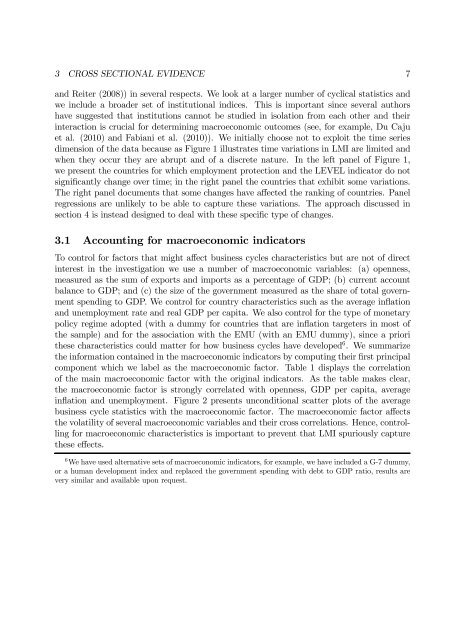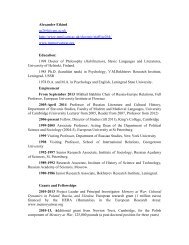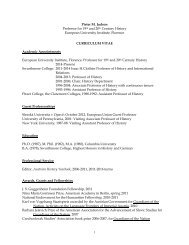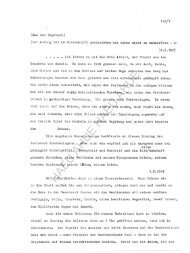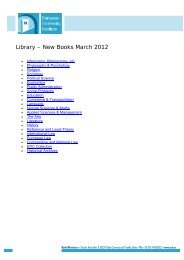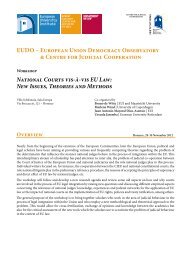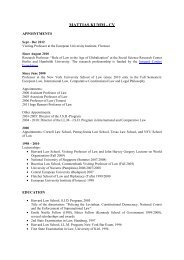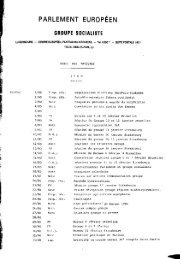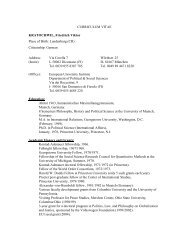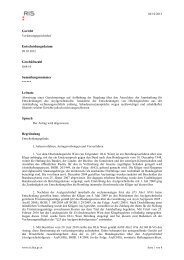Do labor market institutions matter for business cycles?∗ - European ...
Do labor market institutions matter for business cycles?∗ - European ...
Do labor market institutions matter for business cycles?∗ - European ...
You also want an ePaper? Increase the reach of your titles
YUMPU automatically turns print PDFs into web optimized ePapers that Google loves.
3 CROSS SECTIONAL EVIDENCE 7<br />
and Reiter (2008)) in several respects. We look at a larger number of cyclical statistics and<br />
we include a broader set of institutional indices. This is important since several authors<br />
have suggested that <strong>institutions</strong> cannot be studied in isolation from each other and their<br />
interaction is crucial <strong>for</strong> determining macroeconomic outcomes (see, <strong>for</strong> example, Du Caju<br />
et al. (2010) and Fabiani et al. (2010)). We initially choose not to exploit the time series<br />
dimension of the data because as Figure 1 illustrates time variations in LMI are limited and<br />
when they occur they are abrupt and of a discrete nature. In the left panel of Figure 1,<br />
we present the countries <strong>for</strong> which employment protection and the LEVEL indicator do not<br />
significantly change over time; in the right panel the countries that exhibit some variations.<br />
The right panel documents that some changes have affected the ranking of countries. Panel<br />
regressions are unlikely to be able to capture these variations. The approach discussed in<br />
section 4 is instead designed to deal with these specific type of changes.<br />
3.1 Accounting <strong>for</strong> macroeconomic indicators<br />
To control <strong>for</strong> factors that might affect <strong>business</strong> <strong>cycles</strong> characteristics but are not of direct<br />
interest in the investigation we use a number of macroeconomic variables: (a) openness,<br />
measured as the sum of exports and imports as a percentage of GDP; (b) current account<br />
balance to GDP; and (c) the size of the government measured as the share of total government<br />
spending to GDP. We control <strong>for</strong> country characteristics such as the average inflation<br />
and unemployment rate and real GDP per capita. We also control <strong>for</strong> the type of monetary<br />
policy regime adopted (with a dummy <strong>for</strong> countries that are inflation targeters in most of<br />
the sample) and <strong>for</strong> the association with the EMU (with an EMU dummy), since a priori<br />
these characteristics could <strong>matter</strong> <strong>for</strong> how <strong>business</strong> <strong>cycles</strong> have developed 6 . We summarize<br />
the in<strong>for</strong>mation contained in the macroeconomic indicators by computing their first principal<br />
component which we label as the macroeconomic factor. Table 1 displays the correlation<br />
of the main macroeconomic factor with the original indicators. As the table makes clear,<br />
the macroeconomic factor is strongly correlated with openness, GDP per capita, average<br />
inflation and unemployment. Figure 2 presents unconditional scatter plots of the average<br />
<strong>business</strong> cycle statistics with the macroeconomic factor. The macroeconomic factor affects<br />
the volatility of several macroeconomic variables and their cross correlations. Hence, controlling<br />
<strong>for</strong> macroeconomic characteristics is important to prevent that LMI spuriously capture<br />
these effects.<br />
6 We have used alternative sets of macroeconomic indicators, <strong>for</strong> example, we have included a G-7 dummy,<br />
or a human development index and replaced the government spending with debt to GDP ratio, results are<br />
very similar and available upon request.


